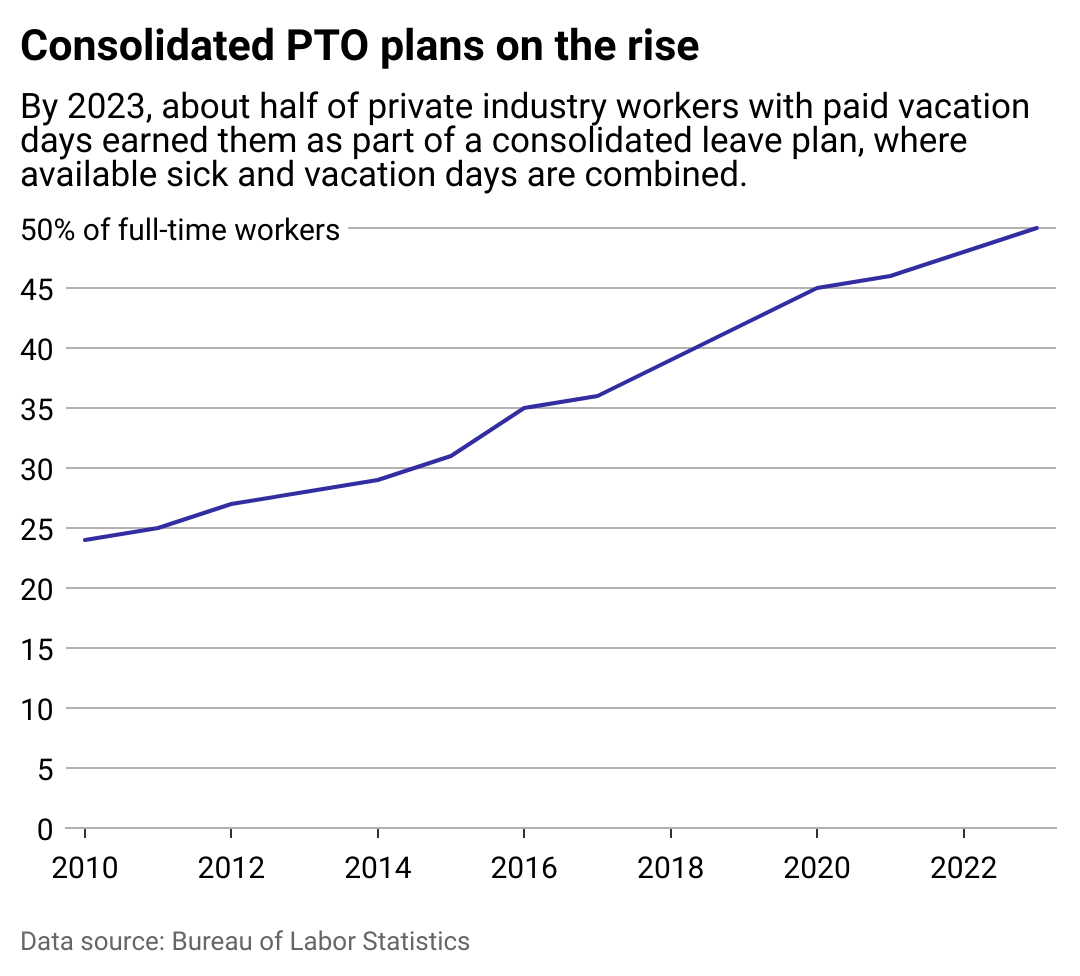Employers are expanding PTO benefits, but are US workers using their days off?

Canva
Employers are expanding PTO benefits, but are US workers using their days off?
A calendar with red and black dates.
American workers consider paid time off one of their most valuable and important benefits—even if they often don’t use all of it.
Fewer than half of U.S. workers with access to PTO took all that was available to them, according to a 2023 Pew Research survey. Those who didn’t take all their PTO said they didn’t feel the need to or worried about falling behind or burdening their teammates. And despite work-life balance becoming a top priority for more Americans in the wake of the COVID-19 pandemic, it ultimately changed little about habits and attitudes regarding sick and vacation days.
Research shows time away from work is good for you, benefitting mental and physical health, interpersonal relationships, and productivity. So why don’t more American workers take all they’re given? Xactly dug into Bureau of Labor Statistics data about private industry benefits and what the research reveals about trends in PTO nationwide.
American attitudes are deeply rooted in that PTO isn’t a given for all workers. The U.S. is one of few industrialized countries with no federal laws guaranteeing PTO. About 8 in 10 private industry workers have paid sick leave, paid holidays, or paid vacation time, BLS data shows. Rates are even lower among hospitality workers and low-wage workers.
With no nationwide laws in place, American employers also give fewer days off on average than what’s mandated in many other high-income countries. Full-time private industry workers receive an average of eight paid holidays and, after one year of service, 11 paid vacation days. The U.K. mandates at least 28 days of paid annual leave for most full-time workers. In Canada, employees are entitled to two weeks of vacation annually after the first year of service, with more guaranteed time off with increasing years of service. In most European Union countries, at least 20 paid vacation days are mandated, with varying numbers of paid holidays.
The U.S. is also one of the few countries in the world that doesn’t entitle all workers to paid sick leave by federal law, although access to the benefit has expanded in the last 13 years due largely to state-level legislation. Still, as with other forms of PTO, most Americans won’t take all their paid sick days and experience stress, fear, and guilt when they do.
Several factors have prevented progress in the U.S on this front. These include historical opposition to federal mandates on PTO, demanding and fast-paced work environments, and a culture that glorifies individual career success and working long hours.
States, counties, and cities have filled in the gaps where federal policy is lacking, though these are far from universal, and coverage varies by jurisdiction. Legislators in Maine, Nevada, and Illinois—as well as a few other localities—have passed laws that allow workers to earn PTO that they can use for any reason. In addition, paid sick time laws exist in 15 states and Washington D.C.
Still, it’s clear that without a federal mandate, paid leave won’t be part of the nation’s collective culture.
![]()

Xactly
The push toward a singular PTO bank
A line chart showing the share of full-time workers who had access to vacation days as part of a consolidated PTO plan.
Employer-provided PTO benefits have been in flux since at least the 2010s. The COVID-19 pandemic accelerated some of the trends examined below, elevating the conversation on rest and restoration among Americans. Some employers modified their PTO policies as a result, and individuals reported finding greater value in taking time away from work.
Over the past decade, one of the biggest shifts in paid leave has been in how it is distributed. Increasingly, U.S. employees are receiving vacation days as part of a consolidated leave plan, meaning that sick days, vacation, and personal days all come out of the same pool of PTO. These plans give employees the flexibility to utilize their days off in the ways they need most. They are simpler to administer and track and can make it easier for employers to encourage other types of time off, such as volunteering, under the PTO umbrella.
Unlimited PTO plans are another kind of consolidated PTO, offering workers as many days off as they can manage while keeping up with work responsibilities. There was a 40% jump in job listings advertising unlimited PTO from 2019 to 2023, according to Indeed data. It’s an attractive option for employers because it saves them costs on vacation days, which they otherwise must pay out in many states. Successful and effective oversight of these plans should be based on employee performance rather than attendance, according to an SHRM analysis.
About half of workers would take a lower-paying job with unlimited PTO, according to a 2022 survey commissioned by Fortune. However, the amount of time workers feel justified in taking off often depends on how much encouragement and support they get from company leaders and how much those leaders model PTO utilization. Employees with unlimited PTO actually took fewer days off than those with traditional, accrued PTO plans, according to a widely cited survey by HR company Namely.
Most employees still work under a traditional PTO plan, in which workers accrue a limited number of paid days off with the potential to earn more based on years of service in the company or industry. In the past decade, the average number of vacation days earned by U.S. employees has grown little, regardless of years of service.
TippaPatt // Shutterstock
Other ways employers are experimenting with PTO
Woman taking notes on calendar desk on table.
In addition to consolidated and unlimited PTO, companies are experimenting with other types of time off. For example, some have offered additional time off as a bonus, performance-based incentive, or team reward for completing a project, which can encourage and engage employees.
Moreover, a small but growing number of jobs are advertised with a four-day workweek. A six-month pilot program recently completed among U.S. and Canadian companies found that employees’ mental and physical health improved when they worked on a 32-hour weekly schedule. Companies that tested this solution saw marked improvements in employee retention. This movement has some traction with federal lawmakers: Earlier this year, Sen. Bernie Sanders introduced a bill that would shorten the U.S. workweek to 32 hours.
A COVID-triggered shift toward remote work and flexible schedules fulfills a similar need for people to rest or step away from work during moments throughout the day and to work during periods when they are most productive. For those who are hesitant to take PTO, these options may be able to ease discomfort and encourage them to actually take time off.
Whether interspersing remote work days throughout the year, taking a longer vacation, or crafting a daily schedule to better balance family obligations, having more options may help shift U.S. culture closer to reaching the ongoing benefits of taking time off.
Story editing by Alizah Salario. Copy editing by Paris Close. Photo selection by Clarese Moller.
This story originally appeared on Xactly and was produced and
distributed in partnership with Stacker Studio.
